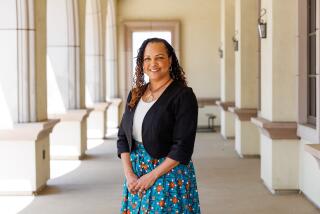She Cheated Death, Now Fights for Normal Life
- Share via
LA MIRADA — Esther Salvatierra, her round face flushed beneath brown curls, groped for words in her La Mirada High School classroom, recalling the car accident eight years ago in which she nearly died.
“My brother died,” the 18-year-old said. “My family hurt real bad. Me, too. (Afterward), I was a baby again. I speak ABC. My eyes see nothing--not my family, not my friends. I know nothing.”
In the accident, Salvatierra lost the use of the left side of her brain, which controls language usage and comprehension. She was left partially blind and paralyzed, without speech or memory. Doctors said she would not survive.
But Salvatierra, now a plump, cheerful senior in special education classes, has been proving the experts wrong for years.
With two months until graduation, she reads at fourth-grade level, walks with a cane, sings in a church choir and speaks--though haltingly and with limited use of tenses and vocabulary--both English and Spanish. Over the years, most of her vision has returned.
Although damage to the left side of the brain has left her with aphasia, or severe difficulty in understanding and using words, she has shown surprising progress in art, a right-brain function.
In art classes at La Mirada High with students from the regular program, Salvatierra learned to work independently and has made strides in freehand drawing. Last month, the school featured an exhibit of her ceramics--two clay bears, a floppy-eared dog, a brown mug and a bowl.
“She is just an inspirational person,” said ceramics teacher Bob Oskin. “She is a survivor--really, really, really a survivor. The other students could see just how hard she was trying.” Even among regular students, he said, Salvatierra stands out for her “effort and willingness to try.”
Along a painful path of rehabilitation, Salvatierra discarded a wheelchair, a helmet (to prevent injuries in case of a fall) and casts on her arms and legs.
She also discarded the word “can’t”--if, indeed, she ever knew it.
Rises to Challenge of Potter’s Wheel
Ceramics teacher Al Carlson recalled telling Salvatierra that she would not be able to operate the potter’s wheel with one hand.
“The next thing I know,” Carlson said, “she’s over there with the wheel and with one hand and she had moved the pedal over to her good foot.” Eventually, he said, she made some “really kind of neat things” on the wheel, requiring help only in positioning the clay.
“She really surprised me,” Carlson said. “She’s so headstrong, so persistent about succeeding in everything. Everything she started, she always wanted to finish.”
By contrast, Carlson said, most of his other students, who are all in the regular program, “give up fast if they can’t do it the first time.”
In a recent art class, Salvatierra proudly displayed a color drawing of a woman on horseback that she had copied freehand from a print.
“This very hard,” Salvatierra said. “I make this by hand--no help. First, I sloppy with the nose, the eyes. Now, I learn how to draw with left hand.”
Carefully, she began to copy a Donald Duck cartoon, drawing and erasing with one hand, oblivious to a group of girls discussing the spring prom at a nearby table.
Works While Others Socialize
“Esther’s never idle,” said art teacher Jack Friedrich. “A lot of other students are just interested in socializing.”
Salvatierra, it is clear, is interested in doing everything an able-bodied person can do.
She wears eye makeup, colored stockings, tinted glasses and bangle bracelets. She wants to learn how to cook and do her laundry. And right now, she wants to persuade a doctor that she no longer needs a cane. To avoid using it at school, a teacher said, she frequently hides it in an art classroom during the day.
” . . . because I’m walking better, not tripping,” Salvatierra explained with a smile.
Most of all, her mother says, Salvatierra wants to learn how to drive.
“It gives me strength just to see how she tries, how she pushes herself,” Zoila Salvatierra said in Spanish. “She has never, ever been bitter.”
Before the accident, her mother said, Salvatierra was being considered for the gifted program at school and dreamed of being a nurse. Now, on the brink of graduation from high school, her future is unsure.
Programs for Handicapped Available
Programs for the handicapped that Salvatierra may be able to enter include on-the-job training, Regional Occupational Program classes, extended training in high school, state-funded sheltered workshops and courses for the disabled at community colleges, said David Barraza, a program supervisor in the Norwalk office of the state Department of Rehabilitation.
The department had decided in 1983 that Salvatierra was too disabled to qualify for its job-training program, Barraza said. Instead, she was recommended for placement after graduation in a sheltered workshop with one of the state’s regional centers for the developmentally disabled. In those workshops, severely handicapped adults typically assemble parts for factories.
That decision did not sit well with Dennis Sproule, Salvatierra’s special education teacher for government and language arts. Sproule believes she is capable of becoming self-sufficient and working in a more skilled job than those offered in the sheltered workshops.
To resolve the dispute, the department has decided to update its evaluation of Salvatierra, Barraza said. Within the next month, he said, Department of Rehabilitation officials will meet with her mother, teachers and the school psychologist to determine if she now qualifies for a job-training program.
“Esther can do a lot of things,” Sproule said, “but the speed is not there that most employers require. If we could just find an employer who could find time to help her.”
Teacher Carlson is also concerned that after graduation, Esther “won’t get the attention she does here. I hope something really happens for her. She was always so intense about learning.”
More to Read
Sign up for Essential California
The most important California stories and recommendations in your inbox every morning.
You may occasionally receive promotional content from the Los Angeles Times.













